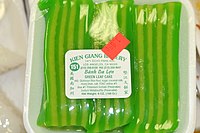 Bánh da lợn lá dứa green leaf cake with pandan leaves flavor | |
| Type | Layer cake |
|---|---|
| Course | Snack, dessert |
| Place of origin | South Vietnam |
| Region or state | Southeast Asia |
| Main ingredients | Rice flour, tapioca starch, mung beans, taro or durian, coconut milk or water, sugar |
| Similar dishes | Kuih lapis, Kutsinta |
Bánh da lợn or bánh chín tầng mây or bánh da heo [1] ( lit. 'pig skin cake') is a Vietnamese steamed layer cake made from tapioca starch, rice flour, mashed mung beans, taro, or durian, coconut milk and/or water, and sugar. It is sweet and gelatinously soft in texture, with thin (approximately 1 cm) colored layers alternating with layers of mung bean, durian, or taro filling.
Typical versions of bánh da lợn may feature the following ingredients:
- Pandan leaf (for green color) with mung bean paste filling
- Pandan leaf (for green color) with durian filling
- Lá cẩm (leaf of the magenta plant, Peristrophe roxburghiana; imparts a purple color when boiled) with mashed taro filling
In modern cooking, artificial food coloring is sometimes used in place of the vegetable coloring.
A cake called kuih lapis, which is made in Malaysia and Indonesia, is similar to bánh da lợn. In the Philippines, a similar dessert and variant of kutsinta is simply called Vietnamese kutsinta and the Khmer of Cambodia call it num chak chan (នំចាក់ចាន់).
-
Bánh da lợn green leaf cake
-
Bánh da lợn green leaf cake with durian flavor
See also
Notes
- ^ The "d" in "da" is pronounced like a "z" in northern Vietnamese pronunciation and like a "y" in southern Vietnamese pronunciation.
External links
- Photo of bánh da lợn (the green cake in the center)
- Photo of bánh da lợn
- Alice's Guide to Vietnamese Banh
 Bánh da lợn lá dứa green leaf cake with pandan leaves flavor | |
| Type | Layer cake |
|---|---|
| Course | Snack, dessert |
| Place of origin | South Vietnam |
| Region or state | Southeast Asia |
| Main ingredients | Rice flour, tapioca starch, mung beans, taro or durian, coconut milk or water, sugar |
| Similar dishes | Kuih lapis, Kutsinta |
Bánh da lợn or bánh chín tầng mây or bánh da heo [1] ( lit. 'pig skin cake') is a Vietnamese steamed layer cake made from tapioca starch, rice flour, mashed mung beans, taro, or durian, coconut milk and/or water, and sugar. It is sweet and gelatinously soft in texture, with thin (approximately 1 cm) colored layers alternating with layers of mung bean, durian, or taro filling.
Typical versions of bánh da lợn may feature the following ingredients:
- Pandan leaf (for green color) with mung bean paste filling
- Pandan leaf (for green color) with durian filling
- Lá cẩm (leaf of the magenta plant, Peristrophe roxburghiana; imparts a purple color when boiled) with mashed taro filling
In modern cooking, artificial food coloring is sometimes used in place of the vegetable coloring.
A cake called kuih lapis, which is made in Malaysia and Indonesia, is similar to bánh da lợn. In the Philippines, a similar dessert and variant of kutsinta is simply called Vietnamese kutsinta and the Khmer of Cambodia call it num chak chan (នំចាក់ចាន់).
-
Bánh da lợn green leaf cake
-
Bánh da lợn green leaf cake with durian flavor
See also
Notes
- ^ The "d" in "da" is pronounced like a "z" in northern Vietnamese pronunciation and like a "y" in southern Vietnamese pronunciation.
External links
- Photo of bánh da lợn (the green cake in the center)
- Photo of bánh da lợn
- Alice's Guide to Vietnamese Banh

